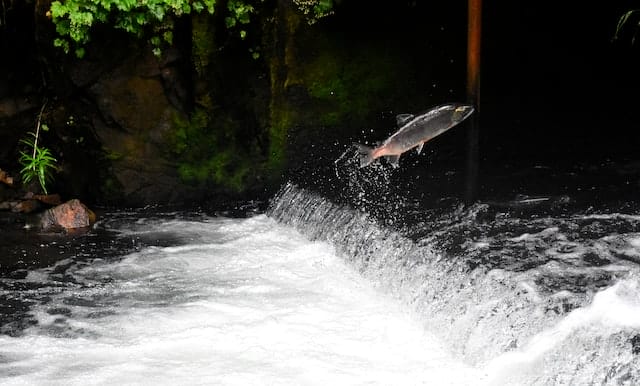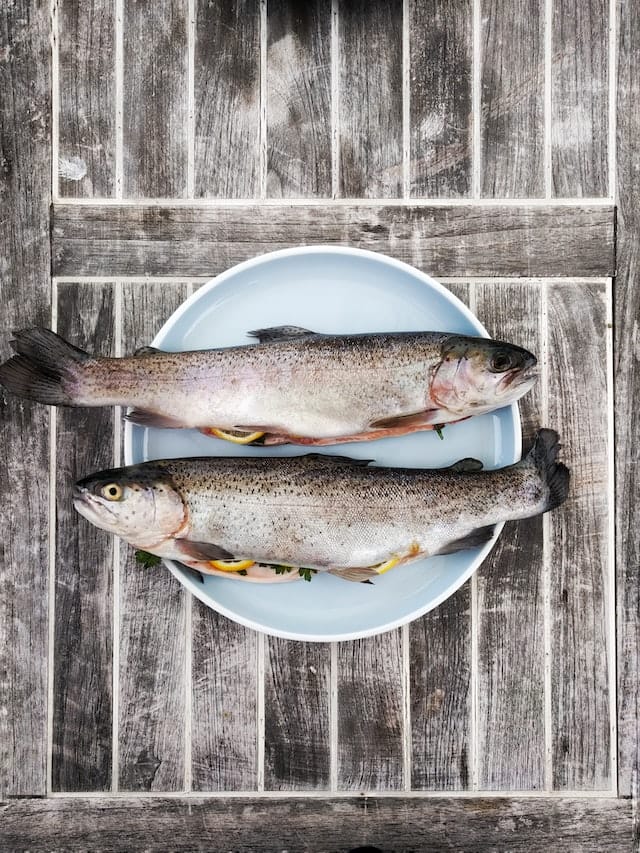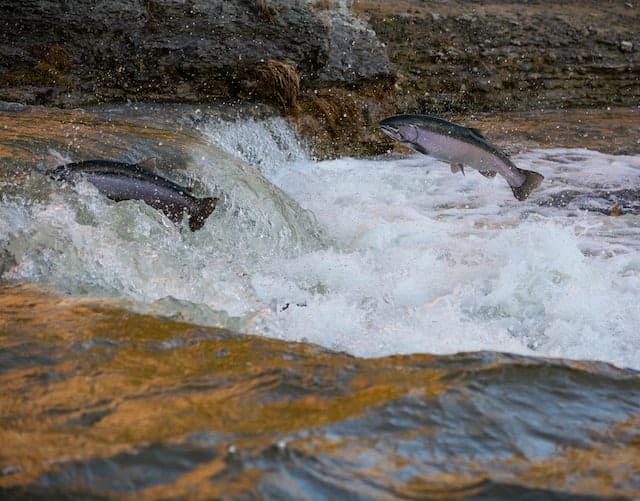
Salmon is one of the most iconic fish species in the world, and it has been an important source of sustenance and livelihood for many cultures since ancient times.
Though they are relatively well-known, there are still some interesting facts about this incredible creature that may surprise you.
Here we explore some of the fascinating characteristics and behaviors of salmon that make them so unique and revered.
From their remarkable migration patterns to their special adaptations, there is much to learn about the impressive salmon species.
Read on for some interesting salmon facts!
Fact #1: Salmon have an incredible sense of smell
Salmon have an incredibly acute sense of smell and use it to identify suitable spawning grounds.
They are able to detect chemical cues from extremely small concentrations of particular compounds in the water, allowing them to navigate hundreds or even thousands of kilometers back to their native streams.
This remarkable ability is one of the key factors in successful salmon migrations and has allowed them to survive for thousands of years in the wild.
In addition, salmon can detect changes in water temperature and other environmental cues with their highly sensitive olfactory system.
This gives them an edge when it comes to avoiding predators or locating food sources.
Fact #2: Salmon have special adaptations for surviving in the ocean
Salmon are well adapted to living in the ocean, thanks to several specialized features that enable them to survive harsh conditions and long migrations.
They have thick, slimy mucus that coats their skin and helps them move through the water more quickly and efficiently.
Additionally, salmon have a unique form of oxygen storage which allows them to survive in low-oxygen environments.
Their gills contain a specialized organelle known as the rete mirabile, which is filled with red blood cells and is responsible for storing oxygen.
This organelle enables them to remain active in areas with low dissolved oxygen concentrations, as well as on their long migrations out to sea.
Fact #3: Salmon migrate thousands of kilometers in their lifetime

Salmon migrations are one of the most remarkable feats in nature.
Every year, salmon travel from the ocean upriver to spawn, sometimes covering hundreds or even thousands of kilometers through challenging environments such as rapids and waterfalls.
During this arduous journey, the salmon must dodge predators, evade obstacles and survive in oxygen-deprived waters.
The impressive endurance of these fish is a testament to their incredible adaptability and resilience—many species of salmon have been known to complete migrations as far as 4,800 kilometers!
Fact #4: Salmon can live for up to 10 years
The lifespan of salmon varies among species, but most are known to have a maximum life expectancy of up to 10 years.
For example, the Chinook salmon has an average lifespan of 7-10 years, while the Coho salmon usually lives for 4-7 years.
During this time, salmon will grow from tiny fry to powerful adults weighing up to 40 kilograms!
Moreover, some species of Pacific salmon are known to die shortly after spawning due to the exhaustion and stress associated with their long migrations.
This makes them especially vulnerable to overfishing or other human activities that could disrupt their migratory patterns.
Fact #5: Salmon are an important part of the ecosystem
Salmon play a vital role in maintaining healthy ecosystems both in freshwater and marine habitats.
In addition to providing food for birds, mammals, and other aquatic species, they provide essential nutrients to freshwater streams and rivers.
Salmon eggs are rich in nitrogen and phosphorus, which help fertilize the soil and promote plant growth.
Moreover, salmon themselves act as an important food source for larger predators such as bears and orcas, helping to maintain an equilibrium between predator and prey populations.
In this way, salmon are an integral part of the natural world, and their importance cannot be overstated.
Fact #6: Salmon are an important part of the diet for many cultures
Salmon has been a staple food source for many cultures around the world for centuries.
From the indigenous peoples of North America to European coastal communities, salmon has long been prized as a nutritious and delicious source of protein.
The fatty acids found in salmon, such as omega-3s and omega-6s, are essential for a healthy diet and may even reduce the risk of certain diseases.
Additionally, salmon is relatively easy to prepare and can be enjoyed in a variety of dishes, making it an incredibly versatile ingredient in the kitchen.
As such, it is no wonder that salmon remains an important part of the diets of many cultures to this day.
- Related post: Guide And Tips – What Is a Good First Pet Fish?
- Related post: Answered: Do Fish Need Sleep And Why It Is Important to Know
Fact #7: Salmon are the lifeblood of many fishing communities

Salmon have long been an important part of the economy and culture in many coastal or riverside towns around the world.
In particular, commercial fisheries dedicated to catching salmon account for a significant percentage of regional income, creating thousands of well-paid jobs in the process.
Additionally, salmon has become a major draw for tourists and recreational fishermen, providing these communities with another source of revenue.
As such, it is clear that salmon are the lifeblood of many fishing communities around the world, not only economically but also socially and culturally.
Fact #8: Salmon are facing many threats
Unfortunately, salmon populations around the world are threatened by a variety of human activities.
Overfishing is perhaps the biggest threat to wild salmon stocks, as commercial fisheries often operate without any sort of oversight or regulation.
Additionally, pollution from industrial and agricultural runoff has caused serious damage to salmon habitats, while the introduction of non-native species, such as trout and bass, can disrupt local ecosystems.
Climate change is also having an impact on salmon populations, as rising temperatures and changing ocean currents are making it more difficult for them to find food and reproduce successfully.
Fact #9: Conservation efforts are helping to protect salmon
In recent years, conservation efforts have been put in place to help protect salmon populations around the world.
In particular, governments and non-governmental organizations have introduced legislation to regulate commercial fisheries better while also increasing public awareness of the importance of sustainable fishing practices.
In addition, habitat restoration efforts have been initiated in order to improve water quality and restore spawning grounds for salmon.
Finally, research into the migration habits of salmon has helped scientists better understand the species and develop more effective conservation strategies for their preservation.
Fact #10: Salmon have cultural significance
Salmon is not only an important part of nature, but they also hold a special place in many cultures around the world.
In some indigenous groups, such as the Pacific Northwest Coast tribes, salmon represents fertility and abundance and is an integral part of their traditional ceremonies.
In other cultures, such as the Vikings, salmon is a symbol of strength and endurance.
Therefore, it is clear that in addition to its economic and ecological importance, salmon also has a deep cultural significance for many societies around the world.
Fact #11: The oldest salmon fossil found is 50 million years old

The oldest known fossil of a salmon was discovered in 2006 and dated back to the Eocene epoch, more than 50 million years ago.
This ancient species, named Pararhincodon typus, is estimated to have grown up to 2 meters in length and weighed up to 40 kilograms, making it one of the largest species of salmon ever known.
This remarkable discovery shines a light on the long history of this iconic species, highlighting its importance for both nature and human cultures over millennia.
Fact #12: Salmon do not eat any food during the time they swim upstream to spawn
During their journey upstream, salmon do not feed at all.
This is due to a unique adaptation that allows them to conserve energy while swimming against the current and gives them enough strength to reach their destination.
As such, the salmon go through a period of fasting, relying on their stored energy reserves to power them upstream.
This remarkable ability highlights the remarkable strength and determination of these iconic fish, which is why they are such an impressive symbol of perseverance in many cultures around the world.
Overall, salmon is one of the most iconic fish species in the world, and there is much to learn about their fascinating biology and cultural importance.
They have adapted to survive in a wide range of habitats, from rivers to oceans, and provide valuable ecological services such as maintaining biodiversity and controlling pests.
Furthermore, salmon play an important role in many cultures around the world and hold a special place in people’s hearts.
With increased conservation efforts, we can ensure that these incredible creatures will continue to thrive for generations to come.
- Essential Oils Safe for Cats: What Every Pet Owner Needs to Know - May 23, 2025
- Herbal Supplements for Cats: A Natural Approach to Cat Wellness - May 21, 2025
- Signs of a Healthy Cat Coat: What Every Cat Owner Should Know - May 19, 2025


GIPHY App Key not set. Please check settings